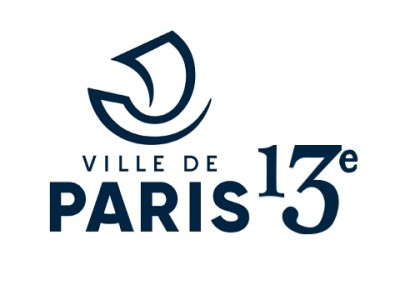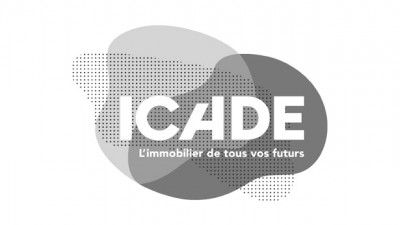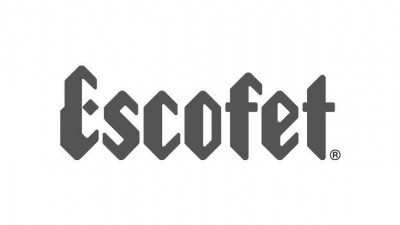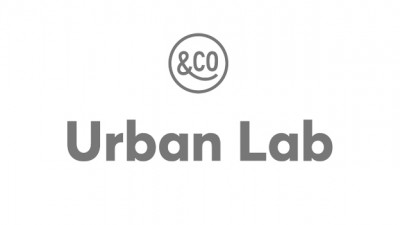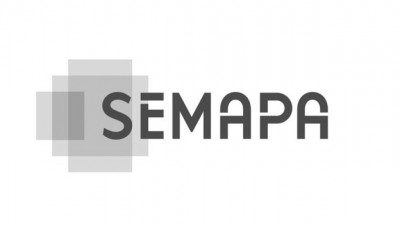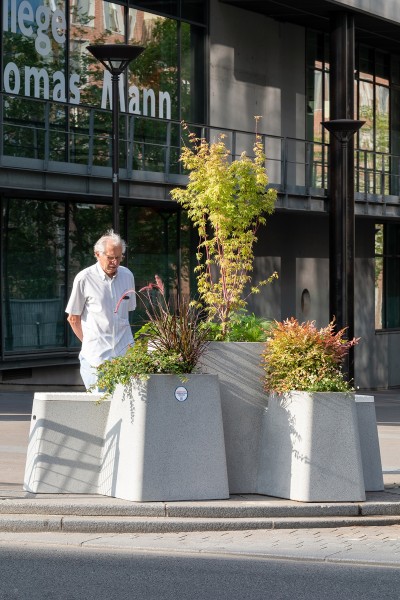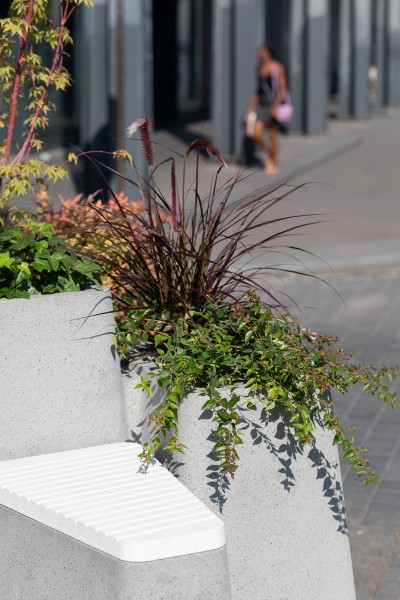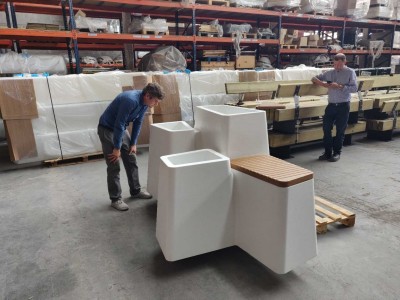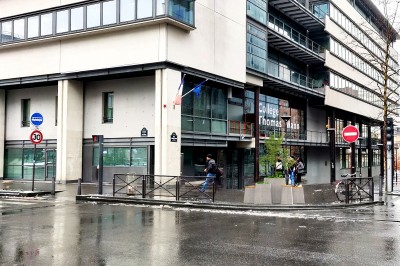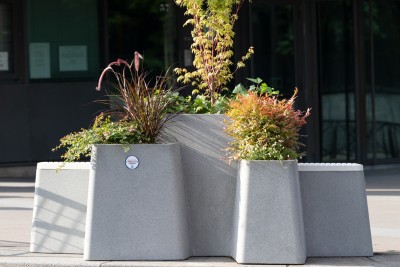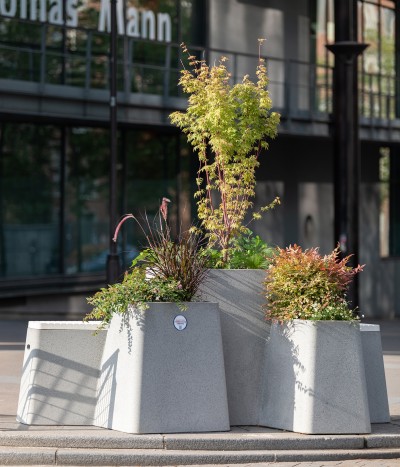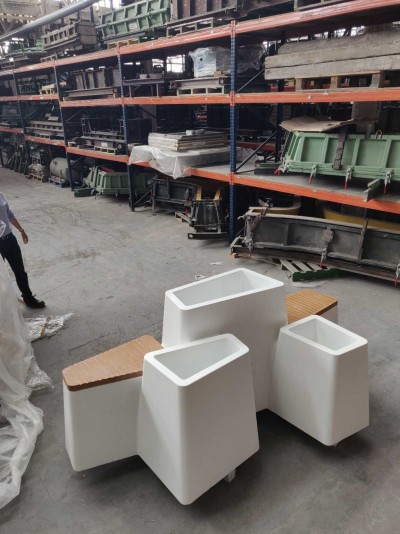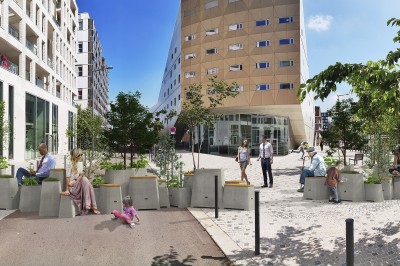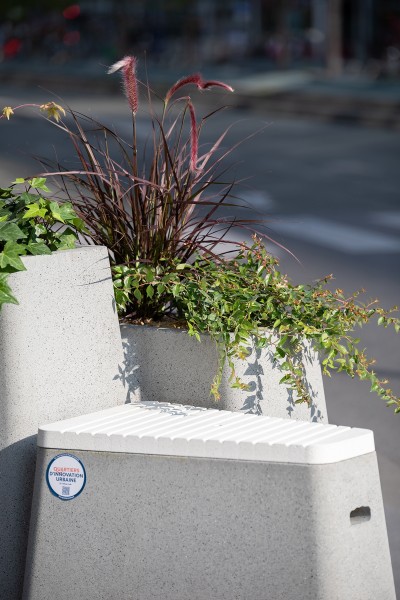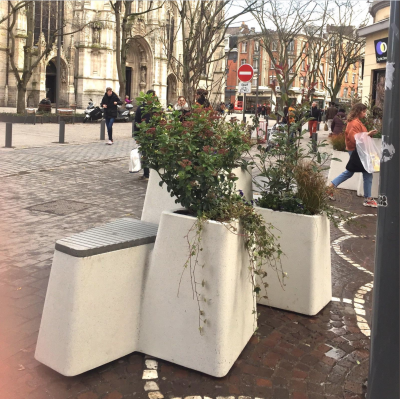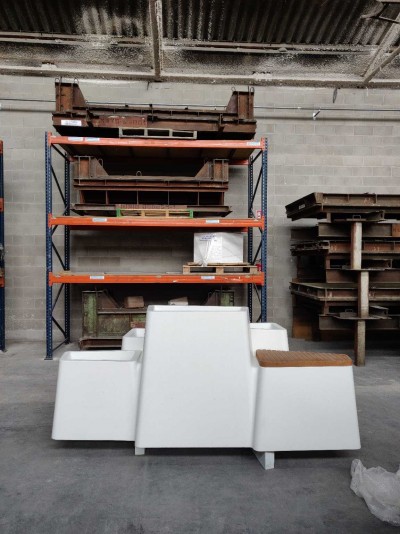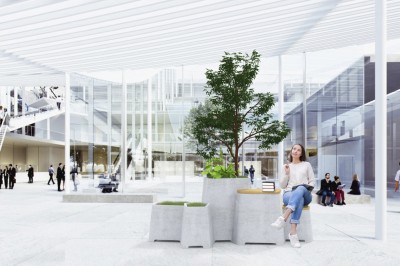The goal is to offer public furniture that provides citizens with multiple services, an ecosystem to support opportunities and protect citizens from the numerous constraints that affect sites. It masters flows, organizes mobility, regulates traffic, prevents parking, and stops heavy vehicles like a cement pylon to ensure the safety of its users.
PROTOTYPES ARE BEING INSTALLED IN CITIES
Like other anti-intrusion furniture, Highfive is capable of withstanding the impact of a heavy vehicle being thrown at it, but the device also makes it possible to better organise, separate and direct the flow of pedestrians, bicycles and cars while also offering new uses. The furniture can accommodate, depending on its specific configurations: seats, plants and small shrubs, lighting poles, posters or decorations for festive events, and eventually wind turbines to produce energy and become a recharging station for bicycles or smartphones or even collaborative and social innovation devices.
Like other anti-intrusion furniture, Highfive is capable of withstanding the impact of a heavy vehicle being thrown at it, but the device also makes it possible to better organise, separate and direct the flow of pedestrians, bicycles and cars while also offering new uses. The furniture can accommodate, depending on its specific configurations: seats, plants and small shrubs, lighting poles, posters or decorations for festive events, and eventually wind turbines to produce energy and become a recharging station for bicycles or smartphones or even collaborative and social innovation devices.
From a technical point of view, Highfive, produced by Escofet, a leader in the urban furniture market, is made up of 5 interlocking planters which also incorporate a novel ground anchoring system triggered in the event of an impact. Each Highfive unit can also be assembled to form a large, impassable chain. These specific features allow the system to be adapted to the problems of each site in order to best meet the security challenge and offer the right balance between protection and user-friendliness.
The Anti-Intrusion furniture is now included in the catalogue of Escofet, a designer and manufacturer of urban elements to transform cities and improve the use of public space.
PROJECT ORIGINS
" Increasingly, the cities of tomorrow will be places of convergence and flux. Our primary mission for these spaces in movement is to envision a new sense of urban-ness to provide uses, comfort, and above all, to create spaces for people to occupy and interact. Our goal is to provide furniture that provides multiple services to citizens, as a place to meet, to relax, share, interact, learn, garden, discover, create, play, explore, and have fun, among many other activities.
We strive to design appropriate ecosystems that can adapt to the specific contexts of their users and their city.
For example, in a square, our devices will provide seating and containers for plants and small trees to provide an environment that encourages gardening and the discovery of biodiversity. During celebratory events, the furniture will be transformed to host lampposts, posters, and decorations. Along riverbanks, the furniture can be equipped with windmills to produce energy and become charging stations for electric bicycles and other devices. Within the neighborhood, the furniture hosts socially innovative devices such as a free speech panel, a box for voting on collective projects, and free libraries, among many others. Everything will be done to encourage users to appropriate such newly arranged spaces in the most natural manner possible. By respecting their needs, we aim to stimulate their willingness to be in these spaces and use them.
To this end, the components will be both functional and decorative. Their presence must give a strong sense of identity to the place, providing continuity of form between the traditional and the contemporary. The challenge lies in responding to the expectations of all users, be they young, old, or disabled. Above all, the furniture will be a community space that strengthens social bonds.
The system will consist of a component that can be repeated and arranged variably to create a unique and unusual space. The idea is to bring more natural elements, functions, and well being by creating a rich, modular space that can be arranged in any number of ways. As a continuous design of an idyllic space, the layout of the components will allow uses to flourish.
Urban spaces are places where people live and interact. Therefore, it is indispensable to protect citizens from the numerous constraints that affect sites. This involves mastering flows, organizing mobility, regulating traffic, preventing parking, and stopping heavy vehicles like a cement pylon to ensure the safety of the users.
By virtue of its composition and design, the furniture will enable this security on a regular daily basis and during special events, both day and night.
As part of a larger management of spaces and user needs, the furniture can be easily moved with a forklift and transported by truck to be used or stored by the city’s municipal services. The city thus becomes a space for listening, expressing, and making! "
PROJECT LEADER
Quentin Vaulot, designer
After graduating cum laude from ENSCI – Les Ateliers, Quentin Vaulot founded his design studio in 2009 in Paris and then moved back to his native Lille in 2016. His work has garnered him numerous awards, including a residency at Villa Kujoyama in 2015. Inspired by science and the beauty of nature, Quentin Vaulot is a designer specializing in disruptive innovation and strategic design. He seeks to create objects and services that are coherent, fair, and honest. An enthusiast of the future, he is constantly exploring the frontiers of creation to imagine how social, economical, technological, and environmental changes can become an impetus for innovations that improve our lives and make the world a better place. His multidisciplinary approach and ever-expanding curiosity have led him to work with all kinds of actors, including micro, small and medium-sized enterprises, cities, museums, foundations and institutions, associations, schools, publishers, galleries, architects, and research institutions.
Quentin Vaulot, designer
After graduating cum laude from ENSCI – Les Ateliers, Quentin Vaulot founded his design studio in 2009 in Paris and then moved back to his native Lille in 2016. His work has garnered him numerous awards, including a residency at Villa Kujoyama in 2015. Inspired by science and the beauty of nature, Quentin Vaulot is a designer specializing in disruptive innovation and strategic design. He seeks to create objects and services that are coherent, fair, and honest. An enthusiast of the future, he is constantly exploring the frontiers of creation to imagine how social, economical, technological, and environmental changes can become an impetus for innovations that improve our lives and make the world a better place. His multidisciplinary approach and ever-expanding curiosity have led him to work with all kinds of actors, including micro, small and medium-sized enterprises, cities, museums, foundations and institutions, associations, schools, publishers, galleries, architects, and research institutions.



